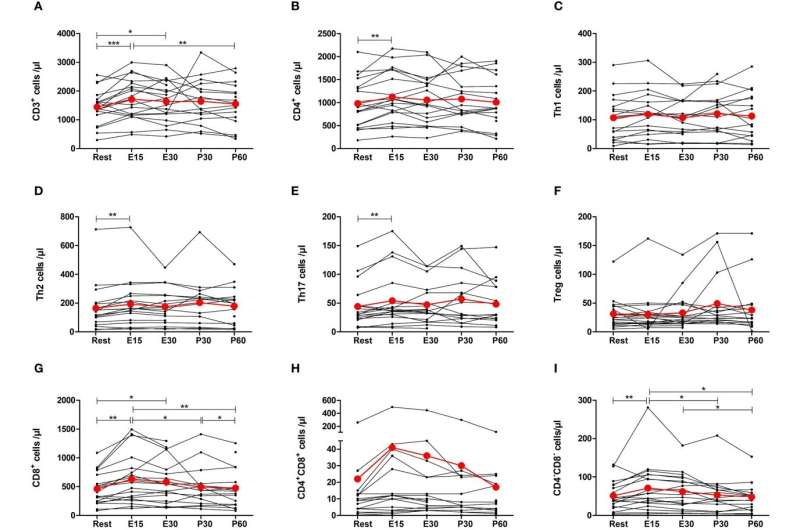This article has been reviewed according to Science X's editorial process and policies. Editors have highlighted the following attributes while ensuring the content's credibility:
fact-checked
peer-reviewed publication
trusted source
proofread
30-minute exercise session found to increase proportion of tumor-killing white blood cells in the bloodstream

A new Finnish study from the University of Turku shows that a 30-minute exercise session can increase the proportion of tumor-killing white blood cells in the bloodstream of breast cancer patients.
White blood cells, the cells of our immune system, fight against cancer, bacteria, and viruses. However, not all white blood cells destroy cancer cells and some can even promote cancer growth.
The most important cell types that destroy cancer cells are cytotoxic T cells and natural killer cells. Cell types that support cancer growth include, for example, regulatory T cells and myeloid derived suppressor cells.
"The balance of different types of white blood cells determines whether the immune system works to destroy cancer or to support it. If there are more cancer-destroying cells than cancer-promoting cells in the tumor area, the body is more capable of fighting cancer," says lead author, Doctoral Researcher Tiia Koivula from the University of Turku, Finland.
Twenty breast cancer patients who had just been diagnosed and therefore had not yet started their cancer treatments participated in the study. During the study, the patients pedaled a bicycle ergometer for 30 minutes at a resistance of their own choosing. Blood samples were taken from the patients at rest before the pedaling, during the exercise, and after the exercise.
Blood samples were analyzed to calculate the amount of many different types of white blood cells, and the amounts measured during the exercise were compared to those at rest.
The study, "The effect of exercise and disease status on mobilization of anti-tumorigenic and protumorigenic immune cells in women with breast cancer," was published in Frontiers in Immunology on 24 June 2024.
During the exercise, the amount of several different white blood cell types increased in the bloodstream. The number of cancer-destroying cytotoxic T cells and natural killer cells increased the most. On the other hand, the number of cancer-promoting regulatory T cells and myeloid derived suppressor cells did not change.
The researchers also examined the proportions of different white blood cell types relative to the total white blood cell count, and found that the proportion of natural killer cells increased significantly, while the proportion of myeloid derived suppressor cells decreased.
"We found that during the exercise, the number and proportion of cancer-destroying cells increases in the bloodstream, while the proportion of cancer-promoting cells either stays the same or decreases. However, it is still unclear whether these changes seen in the bloodstream also lead to changes in the white blood cell counts in tumor area," says Koivula.
"In this study, it was seen that the number of almost all white blood cell types decreased back to resting values one hour after the exercise. With the current knowledge, we cannot say where the white blood cells go after the exercise, but in preclinical studies, cancer-destroying cells have been seen to migrate into the tumor area."
The researchers also analyzed whether different types of breast cancer affect the exercise responses of white blood cells. The researchers found that the larger the tumor, the less the number of natural killer cells increased, and if the breast cancer was estrogen and/or progesterone receptor-positive, the number of cytotoxic T cells increased less than in hormone receptor-negative cancers.
"In our previous study, we found small indications that the type of breast cancer might affect the effects of exercise on white blood cells, which is why we wanted to examine it further. However, the correlations we found were not very strong and therefore, no decisive conclusions can be drawn from the results.
"According to current knowledge, it is beneficial for all cancer patients to exercise, and our recent study supports this notion," Koivula says.
More information: Tiia Koivula et al, The effect of exercise and disease status on mobilization of anti-tumorigenic and pro-tumorigenic immune cells in women with breast cancer, Frontiers in Immunology (2024). DOI: 10.3389/fimmu.2024.1394420





















